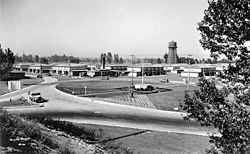Vanport City, Oregon
| Vanport, Oregon | |
|---|---|
| Former city destroyed by flood | |

Vanport in 1943, five years before the flood
|
|
| Coordinates: 45°36′07″N 122°42′00″W / 45.60194°N 122.70000°WCoordinates: 45°36′07″N 122°42′00″W / 45.60194°N 122.70000°W | |
| Country | United States |
| State | Oregon |
| County | Multnomah |
| Elevation | 23 ft (7 m) |
| Time zone | Pacific (UTC-8) |
| • Summer (DST) | Pacific (UTC-7) |
| GNIS feature ID | 1128512 |
Vanport, sometimes referred to as Vanport City or Kaiserville, was a hastily constructed city of wartime public housing in Multnomah County, Oregon, United States, between the contemporary Portland city boundary and the Columbia River. It is currently the site of Delta Park and the Portland International Raceway. Vanport construction began in August 1942 to house the workers at the wartime Kaiser Shipyards in Portland and Vancouver, Washington. Vanport—a portmanteau of "Vancouver" and "Portland"—was home to 40,000 people, about 40 percent of them African-American, making it Oregon's second-largest city at the time, and the largest public housing project in the nation. After the war, Vanport lost more than half of its population, dropping to 18,500, as many wartime workers left the area. However, there was also an influx of returning World War II veterans. In order to attract veterans and their families, the Housing Authority of Portland (HAP) opened the Vanport Extension Center (Vanport College). The college enrolled 1,924 students its first year.
Vanport was dramatically destroyed at 4:05 p.m. on May 30, 1948, when a 200-foot (61 m) section of the dike holding back the Columbia River collapsed during a flood, killing 15. The city was underwater by nightfall leaving its inhabitants homeless.
As a hub of transient laborers from all corners of the country, few residents had any long-term connections with each other and little opportunity or interest to build them. The temporary nature of the new city contributed to an overall sense of insecurity and anxiety among residents. The lack of businesses and recreation opportunities contributed to a sense of distrust, and the relative isolation of the largely male workforce meant there was little demand for community institutions such as a newspaper or high school.
By 1943–44, families living in Vanport were moving out at the rate of 100 a day. A questionnaire mailed to 1,000 former Vanport families, selected randomly from the approximately 3,000 families who had left by then, asked, among other things, why they had moved to Vanport in the first place. About 230 people answered this question. The top reason given for choosing the Portland–Vancouver shipyards was that "they thought it their duty to go into defense work". The second-ranked reason was a desire for a better job, and the third, higher wages. However, the situation changed when the war ended in 1945. HAP then sought to attract World War II veterans who needed housing, a community to raise their families, and higher education through the Servicemen's Readjustment Act (G.I. Bill). The establishment of a college at Vanport in 1946 was a key part of the strategy to keep Vanport a thriving Oregon community.
...
Wikipedia

